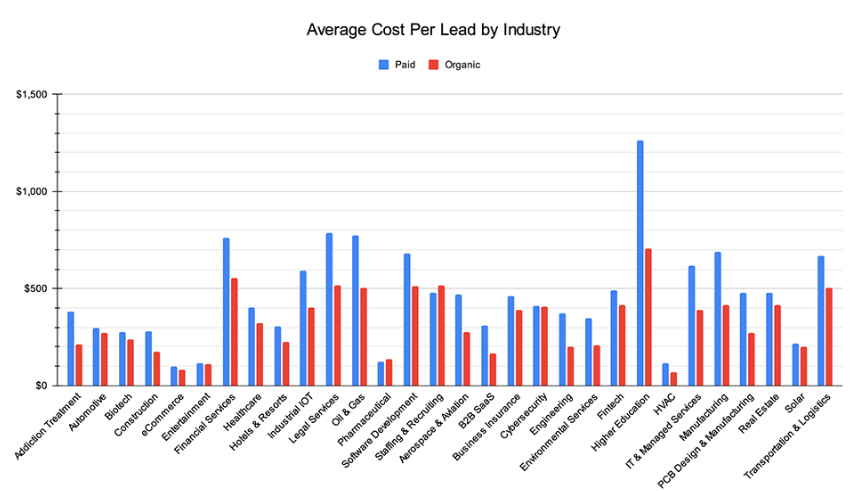If you’re looking for a flexible and scalable online business, lead generation might be your route to riches.
Lead-gen businesses do the heavy lifting for clients when it comes to finding and nurturing customers. They use content marketing and cold-calling techniques to drive a steady pipeline of engaged and high-quality prospects to clients who pay big bucks for these leads.
But while lead gen offers plenty of potential to cash in, it’s also a competitive and dynamic space. So, success means taking a professional approach to your business – do this and the sky’s the limit.
In this guide, we take you through the basic steps to starting a lead generation business. We cover everything from choosing a profitable niche, developing effective lead gen strategies, and attracting those all-important paying clients.
We’ll also explain why Whop is your #1 resource for building your business, leveraging leads and driving growth.
What is a lead generation business?

Lead generation agencies find potential customers (leads) for their clients – who typically operate in the B2B (business-to-business) space.
This might sound simple, but lead gen can be a complex process that includes research, developing optimal strategies, and measuring success.
A lead is generally defined as a direct connection with a prospective customer, whether via phone, email, or in person.
Activities to generate these leads might involve paid ads, cold calling & emailing, and content marketing.
Lead generation is essentially a numbers game. While the percentage varies by industry, on average, only 2-10% of B2B leads actually convert to paying customers. It can be even lower in the B2B software-as-a-service (SaaS) niche.
This means that lead gen firms must do a lot of legwork to find quality prospects and achieve positive results for their clients.
Before we get into the details of how to start a lead generation business, here’s an overview of the pros and cons of starting a lead gen business:
| Pros | Cons |
|---|---|
| ✅ Flexible | ❌ Competitive |
| ✅ Scalable | ❌ Time intensive |
| ✅ Unlimited profit potential | ❌ Start-up costs |
| ✅ Recurring revenue | ❌ Knowledge of marketing needed |
| ✅ Many profitable niches | ❌ Legal compliance |
How do lead generation businesses make money?
There are several payment models used by lead generation firms to generate income. These are:
Front-end: Under this model, the lead gen agency and client agree a fee or flat rate for services or each quality lead, or a percentage of any sales generated.
Back-end: Lead gen firms invest in generating leads, with the client only paying once the leads have been delivered; the price paid reflects the risk.
Hybrid: Clients pay for lead generation and also a commission each time the lead results in a specified action or sale.
Most firms adopt a model where they are paid a monthly fee for their services under a contract or retainer agreement. According to software firm Expandi, retainers can be anywhere from $3k to $20k per month. Not bad…

A typical tiered plan might include the lead gen firm supplying a certain number of leads or making a set number of appointments each month.
Or, like this example from lead gen firm SalesRoad, it might be based on the services provided:

In terms of how much firms make, it can vary widely depending on the niche and the size of the business, as well as the lead generation services offered.
It also depends on profit margin and return on investment. Leads cost money to acquire. So, profitability will hinge on how much you must spend to get those leads and how much clients are willing to pay - we’ll cover start-up costs later in the guide.
In general, smaller lead gen firms make a few thousand dollars, while the larger players can generate millions. So, whether you want a lucrative side hustle or to build a global operation, it’s all within reach.
In fact, according to Business Research Insights, the lead generation market will reach $15.5bn by 2031, up from just $3.1bn in 2021. This highlights that quality leads remain a valuable commodity for companies that are vying for every customer and every dollar.
So, if you can develop a reliable pipeline of genuine prospects in your niche, you can carve off a nice slice of the lead gen pie.
Three examples of lead generation businesses
Before we move on to our step-by-step guide to starting a lead generation business, it’s useful to look at some examples of these firms. Here are just three agencies that offer lead gen services, so you can get a sense of how they work.
1. Belkins

This top-rated B2B-focused agency offers a full suite of lead generation services, including:
✅Appointment setting
✅Cold calling & emailing
✅Lead research
✅LinkedIn lead generation
While Belkins is tight-lipped about how much it charges for its service, it offers two plans, which each come with a range of lead generation features. The site also has lots of resources on sales and marketing topics.
2. LeadGeneration.com

LeadGeneration builds custom lead generation campaigns for companies. Instead of cold calling and emailing, it focuses on techniques like PPC advertising, content distribution, and SEO.
It also offers landing pages, video ads, and full sales funnel tracking – all aimed at delivering premium leads to clients.
3. Pearl Lemon Leads

Pearl offers a range of lead generation and business services, including copywriting. It works across a range of industries, offering firms the ability to outsource such lead gen functions as:
✅Appointment setting
✅Cold calling & emailing
✅LinkedIn lead generation
✅Content marketing
Operating in the U.S. and U.K., the agency claims to offer new clients 20 meeting appointments with leads in their first month of signing up. As well as lead gen services, Pearl offers professional telesales training.
Other examples of lead-generation agencies
A few other agencies operating in this space include:
- CIENCE Technologies
- Martal Group
- Upcall
- Intelligent Demand
- Callbox
While there is overlap in what these agencies offer, they each tailor their features to attract their target clients. This differentiation might relate to the niches and sectors they serve or the scope of their lead gen activities.
As we saw, Pearl Lemon enhances its offering with professional copywriting and email marketing, while CIENCE Technologies focuses on the education, finance, and biotech sectors.
5 steps to starting a lead generation business
Interested? Here are the steps to take to start your own lead generation business.
1. Choose a niche
Lead generation is all about finding high-quality prospects for your clients, so you must target your lead generation efforts. This means finding the right niche.
The overriding thing to think about is potential profitability. You want to focus your efforts in a sector where there is a need for your lead generation services and also where there is the potential to achieve the maximum revenue from the leads you generate.
This kind of revenue comes from businesses with high customer lifetime value, a metric that indicates how much revenue a company achieves on average per customer.
Clients in these niches are willing to pay lead generation companies top dollar for a pipeline of “warm” prospects they can close.
Finding these niches means doing some research. Things to consider include:
- Competition: The more competitive the sector, the more each company will be vying for every customer.
- Demand: The higher the demand for a product or service, the larger the pool of potential customers.
- Products/services: Single purchase big ticket items and recurring services are generally where the real value can be found.
If you need a place to start, we’ve listed some profitable niches later on in this guide.
2. Identify a target audience
To start looking for clients in your niche, it’s important to define your target audience.
This involves building an ideal customer profile (ICP). Similar to a target persona, the ICP is about looking broadly at target segments. Personas include more detail on individual buyers.
For example, let’s say you’re targeting clients in the cybersecurity niche. An ICP may be a mid-size, U.S.-based tech company with a turnover of $5m-$10m and a marketing budget of $500k, which seeks qualified leads for its new cyber-focused suite of tools.
Within that, your target persona might be “Grace”, the firm’s newly appointed head of sales for the cyber-focused suite, who’s active on LinkedIn and must meet her targets each month on an annual budget of $200k.
Together, the ICP and persona will guide your client acquisition efforts and enable you to provide a tailored solution to their needs.
Initially, ICPs are more valuable as they provide a general overview of where clients might be found. In the example above, the firm is likely to be willing to pay well for a list of qualified B2B leads who might want to buy their suite of products.
Later, personas come into play as you personalize and refine your marketing efforts to find clients and send them qualified prospects. Approaching “Grace” through LinkedIn and offering your lead generation services might land you a valuable client.
However, before you dive in and start reaching out to potential clients, you must have something to offer. So, once you know your niche and your target clients within that niche, you need to build your lead list.
3. Build a lead list
A lead list comprises contact information for relevant individuals who might be interested in buying products or services in your niche. You want to compile a list of names, job titles, companies, and phone numbers, as well as (verified) email addresses.
There are various ways to find this information, including:
- General research: This is a time-intensive approach that involves going through LinkedIn, company websites, and other sources to log contact details.
- Keeping on top of industry developments: If a company in your niche makes a key hire, or a new company launches, it might offer valuable leads.
- Email scraping: There are tools available that collate email addresses from websites and social media platforms (this has potential legal issues – we cover this topic later in the article).
- Third-party databases: It’s possible to purchase contact lists but, as well as legal issues, the results can be patchy with out-of-date details and unverified email addresses.
Not every person who fills in the form or responds to an ad will be a quality lead. However, a list of leads allows you to conduct outreach to nurture the leads on behalf of your clients to turn them into viable prospects.
4. Attract clients
One of the factors that makes starting a lead gen business challenging is that it requires two lots of marketing. Not only do you have to market clients’ products and services to leads, you have to find clients who want those leads.
So, once you’ve developed your ICPs and target personas and got together a lead list, you have to create an online presence that sets out who you are and what you do.
With lots of lead gen agencies operating out there, it’s important to define your offer. Here are some examples of how lead-gen agencies frame their offers.
Leadium:

RocketReach:

CallBox:

One place you should definitely check out is LinkedIn – this is where B2B clients and customers can be found.
Ultimately, lead generation is a competitive and results-driven industry. So, if you prove to your clients that you can deliver a database of quality leads, you can make your mark in this competitive space.
5. Develop lead generation strategies
Clients don’t just want a list of email addresses – they want quality leads who have proven to be at least somewhat interested in the products/services.
This is where your marketing efforts come in, nurturing prospects and turning them into qualified leads.
We go through the main lead gen strategies in the next section. However, as an overview, the keys are to develop optimal strategies that focus time and resources most effectively.
For example, if your audience is mostly on social media, that’s where your efforts should be focused. Similarly, if they’re more likely to be reading trade publications and attending in-person networking sessions, your social media efforts might not generate positive returns.
Remember that to make money in lead gen, you need to understand the cost per lead in your niche. Working out lead generation cost is a simple equation:
Cost of strategy divided by number of leads it generates
E.g.: $1k of advertising divided by 50 leads = $20 per lead
This cost varies between industries. For example, in retail, the average is around $55 while in technology, it’s closer to $200. Here’s an overview of average cost per lead by industry (courtesy of First Page Sage)…

This is how much it costs you to generate quality leads. The difference between that cost and what you charge clients will determine your profitability. So, you need to develop strategies which will pay off – for you and your clients.
Lead generation techniques & strategies
So, what does lead generation actually involve? Essentially, it’s a marketing function that requires you to employ strategies to identify and nurture potential customers who would likely be interested in your client’s products and services.
The important thing to consider is that clients want leads who are ready to buy. These are customers who know they have a problem and understand that your client’s product or service could solve that problem.
In other words, they are towards the bottom of the marketing funnel.
Don’t know what a marketing funnel is, or even if you need one? Read our guide to discover everything you need to know about marketing funnels.
By the time your client makes contact with these prospects, they have proven themselves to be interested in what is being sold. The client’s sales team then moves in to close the sale.
Types of lead generation
Lead generation can broadly be divided into two groups of activities.
Outbound marketing is more upfront in nature and involves actively pushing the product or service. Examples of outbound marketing include:
⬅️ Paid ads (social media, banners, LinkedIn, etc.)
⬅️ Cold calling
⬅️ Direct mail
Inbound marketing is subtler in its approach, which is more focused on educating the customer base and providing useful information. Examples of inbound marketing include:
➡️ Email marketing
➡️ SEO
➡️ Social media engagement
➡️ Content marketing
The mix of strategies you employ will depend on the niche and target customer, which is one of the main challenges. You need to figure out the best ways to engage and nurture your leads.
Knowing which lead gen strategy to use
For B2B clients who sell big-ticket items, such as manufacturing equipment, the winning approach is likely to be more personal, with salespeople actively reaching out to prospects.
Customers in this space have large budgets and very specific requirements. They would rather read a detailed white paper then have a sit-down meeting to go over the specs than be lured by a Facebook ad. In this case, the lead gen focus might be on cold calling, trade shows, or LinkedIn outreach.
However, for a firm in the software space, a more effective strategy might be to employ inbound techniques including optimized blog posts and a social media presence highlighting the product’s advantages.
In this case, an engaging and information-driven approach based on educating customers and demonstrating the software in action might generate more engagement. The end goal here might be to get prospects to fill in a form requesting a personalized demo, so the firm gets a personalized contact and can try to land a sale.
The point to emphasize is that it’s important to understand your client’s target market then tailor your strategies to maximize customer engagement.
The price of acquiring leads depends on the niche and the strategies employed. Strategies like pay-per-click (PPC) ads focused on keywords with high levels of competition will likely be pricier than an active social media presence, which attracts quality leads organically.
Lead generation tools & platforms

Much of the lead gen process can now be automated and enhanced by AI. On one hand, this means some potential clients might integrate this software into their own processes rather than engage an agency. However, on the other hand, it presents opportunities for you to streamline your lead-gen offering.
So, let’s move on to look at just a few of the tools available to help you in your lead generation efforts. There are lots out there, some of which are comprehensive sales and marketing platforms, while others are focused on a specific strategy.
Sales and marketing platforms
A few examples of lead generation software and platforms are:
🏆Whop: An all-in-one platform that supports a range of lead-generation activities. This includes building an engaged community and providing downloadable content, as well as other types of marketing and customer relationship management (CRM) activities. Its community focus makes it especially good for attracting motivated leads.
Cost: Free to start then from 3% per transaction

Salesforce: A leading CRM platform, Salesforce facilitates the process of finding prospects, closing sales, and nurturing connections. The CRM functionality allows you to develop detailed profiles of your customers to help tailor marketing strategies.
Cost: Paid plans range from $25 to $500 a month, with bespoke enterprise pricing available.
HubSpot: This is a well-known all-in-one platform that provides a full suite of sales, marketing, and customer service tools. It offers a range of paid plans, which are centered on its core Hubs. The sales and marketing hubs are where the lead gen value can be found.
Cost: There’s a limited free plan, while paid plans range from $16 to $3.6k
ClickFunnels: Provides sales, marketing, and analytics tools, with a focus on sales funnels to drive conversions. It supports lead gen activities like email marketing, landing pages, and blogs. This is a well-regarded platform, but not the cheapest option out there.
Cost: The monthly plans are $97 and $297, with a 14-day free trial.
Specialized tools
Here are some tools which focus on one or more marketing functions.
Mailchimp: Offers tools for sending emails, ads, and automating marketing campaigns. A free plan is available, with paid options costing $13 to $350 a month.
OptinMonster: Provides a suite of tools aimed at generating subscribers, leads, and sales, including lead capture forms. Usual prices are $18 to $123 a month.
LeadPages: Supports the creation of landing pages to generate leads. Paid plans cost $49, $99 or $697 a month.
ActiveCampaign: An AI-driven marketing automation platform, which is especially good for email marketing. Plans cost between $15 and $145 a month, with a 14-day free trial.
Buffer: One of the cheaper social media scheduling tools that can save time and ensure your posts go out when they are most likely to get traction. There’s a free plan, with paid options starting at $12 a month after a 14-day free trial.
LinkedIn: A social media platform for business, it also supports networking, paid ads, and content, making it a valuable lead gen tool. Free to create a profile, with Premium plans costing between $29.99 and $170 per month.
Looking for more sales and marketing platforms to help with lead gen? Check out our list of ClickFunnels alternatives and our pick of the best content marketing tools.
Measuring and analyzing success
One key element of running a lead generation business is measuring your results. This is important for your bottom line. After all, you want to retain paying clients and ensure you are increasing the profitability of your agency.
We come back to the simple metrics of time and return on investment. To achieve profitability and growth, your total outlay needs to result in positive outcomes for you and your clients.
So, it’s crucial to continually monitor your lead generation activities and adjust accordingly. If you’re plowing hours and dollars each month into email marketing with little to show for it, maybe those resources are better directed to Google, LinkedIn or social media ads or cold calling.
Initially, there is likely to be a period of trial and error as you find your feet. However, there are ways in which you can flatten this learning curve.
Set targets: How can you know if you’re successful without knowing what success looks like? For each lead gen technique you employ, set targets, whether that’s email opening rate or social media engagement.
If you are selling clients packages that guarantee a certain outcome, make sure you can deliver this each month.
A/B testing: This is a much-used technique that simply involves comparing two versions of something to discover which has the most traction. For example, you can test things like:
- Email wording
- Calls to action (CTAs)
- Ad text
- Form layouts and colors
- Cold calling scripts
Invest in lead gen analysis software: If your budget is limited, one potentially worthwhile investment is software that offers data analysis capabilities.
Ultimately, the main way to know if you’re being successful is to integrate measurement and analysis into all your lead gen strategies. Make it a part of your everyday activities to review where your leads are coming from, including which sources lead to the highest conversion rates.
It may take time, but in the long run, understanding the numbers means you can adapt and pivot accordingly – which is only going to help your clients and your bottom line.
Legal compliance for your lead gen business
We can’t talk about how to start a lead gen business without flagging the importance of legal compliance.
Why? Because lead generation is all about finding prospects and passing their details to a third party – this has the potential to breach all kinds of data protection and privacy laws.
In particular, some lead gen “strategies” such as email scraping or purchasing lead lists from third parties can be problematic, as we mentioned earlier.
The good news is that at its core, data protection is pretty simple. How you’d want a company to handle your personal info is basically how you should approach handling other people’s. The important concepts to respect are:
✅ Ensure users consent to their data being collected and shared
✅ Always be transparent about data storage and use
✅ Have a clear and easy opt-out process
✅ Stick to the rules about collecting and storing data
✅ Minimize the amount of data you collect from users
✅ Post clear privacy policies on your site
The even better news is that many of the tools you use in your business will have some kind of data privacy protection built in. For example, legally compliant form builders and boilerplate privacy policy text.
So, what are “the rules”? Well, different data protection rules and regs apply across countries, regions, and states. However, key laws include:
⚖️ California Consumer Privacy Act: Applies when collecting data from individuals located in California.
⚖️ CAN-SPAM Act: Covers commercial communications (emails) sent in the USA.
⚖️ General Data Protection Regulation (GDPR): Covers data protections across the European Union.
⚖️ Canadian Anti-Spam Legislation: Applies to electronic communications sent by companies to Canadian residents.
⚖️ U.K. Data Protection Act: This relates to the U.K. but largely incorporates the provisions of the GDPR.
Lead generation is a cross-border activity so be sure to check out the obligations which apply to you. It’s also important to keep alert to any changes or updates to the rules – the trend has been towards enhanced protections.
As well as keeping you out of hot water, showing clients that you understand and comply with the rules is a great way to build authority and respect as you grow your lead gen business.
Most profitable lead generation niches
Maybe your choice of niche is obvious. However, if you’re here to find out how to start a lead generation business from scratch – or you just want the biggest bang for your buck – we’ve found some profitable niches to explore.
These niches are not just where the highest-paying clients can be found, they are also where there is the strongest need for quality leads.
- Financial services: Clients will pay well for prospects who are interested in valuable products like banking, loans & mortgages, and insurance. (Cost per lead $150-$400)
- Technology: Companies in this space traditionally spend a lot on sales and marketing, as well as operating in a niche where competition for customers is fierce. (Cost per lead $200-$300)
- Ecommerce: As well as being lucrative, ecommerce is a space where you can leverage social channels to drive engaged customers to your clients. (Cost per lead $5-$25)
- Software-as-a-service: Another competitive niche with high-profit potential for lead gen firms which are up to speed on the latest trends and target customer base. (Cost per lead $50-$200)
- Consulting firms: Consulting firms charge a lot for their specialist services, so lead gen agencies in this space can cash in by delivering the right leads. (Cost per lead $200-$1k)
- Education: Institutions and edtech firms are all vying for students and customers, so will pay for effective lead generation services to communicate their offer (Cost per lead $55-$65)
Remember the retainers that companies are willing to pay for quality lead generation services can range from $3k to $20k – the higher the cost per lead, the more you can charge.
How much does it cost to start a lead gen business?
So, how much will it cost to set up and run a lead gen agency? This will depend on several factors, including the size of your business.
Starting a one-person business will be a lot cheaper than trying to go big. However, there are some essential start-up costs for businesses of all sizes. These include:
Website domains & hosting: You want an online presence, which will typically involve a professional website, so you’ll need to pay for a domain and web hosting.
💰Cost: Up to $500 a year
Paid tools: From lead generation automation to email marketing and contact forms and landing pages, to run your business effectively you might want to invest in paid tools.
💰Cost: Up to $100 a month
Lead generation strategies: Again, this widely varies between niches. As we saw, the average cost per lead averages around $200 with a range of $50 to $400+.
💰Cost: Variable
Marketing strategies: These costs relate to what you spend on promoting your services to potential clients. This will vary by niche and by your client base.
💰Cost: Variable
Overall, you might need to budget up to $1.5k to get started on a small scale. This can rise to 10s of thousands for a large-scale operation.
However, it’s all balanced against the money you make. Whatever pricing model you adopt, your costs will be reflected in what you charge clients for your services.
Again, that’s why it’s important to understand your cost per lead so you can price your services to cover your expenses, plus a healthy profit.
There are also ways to keep your start-up costs low. For example:
✅ Run your business from home to save money on office space.
✅ Cut down on the number of paid tools you use or take advantage of free trials/plans while you’re starting out.
✅ Opt for less costly lead gen techniques that are still effective in your niche.
✅ AI writing tools can help with some content tasks, saving time and the cost of bringing in outside support.
✅ Introduce a pay-up-front model so you have a steady income from the start.
Another great way is to build your business on a cost-effective platform that makes it easy to connect with clients and market your services.
This is where Whop comes in…
Take the lead with Whop

How can Whop help you start a lead generation business?
Well, first of all, we’re the ultimate one-stop-shop for building, running, and scaling an online business – so all the tools you need to grow are right here.
Sign up for a free account, create your very own “whop” online storefront, and be on your way to success by the end of the day. Yes, it’s just that easy.
You’ll save hours of effort in creating a website – not to mention the related costs, including hosting. With us, you only pay when you start making money (and we charge from just 3% per transaction).
We offer the ability to monetize however you want. So, for example, you can offer a free trial then tiered packages based on – say – the number of leads clients can expect each month. Easy.
But that’s not all. Through our thriving marketplace, you have access to millions of potential clients across multiple niches. These clients are all seeking quality prospects they can convert into paying customers.
Need more? We offer a range of flexible apps you can add to your site, which are perfect for lead gen, such as…
✅ Calendar Bookings: Makes booking client meetings a cinch
✅ Video Calls: Host seamless online meetings with clients and leads
✅ Content: Produce expert guides and other content that helps your clients up their conversion rates
You can even expand into courses and webinars to share your expertise and cement yourself as an authority in the lead gen space.
As you can see, we’ve got everything you need – and more. So, if your dream future lies in starting a lead gen business, join us today and let Whop lead the way to success.





